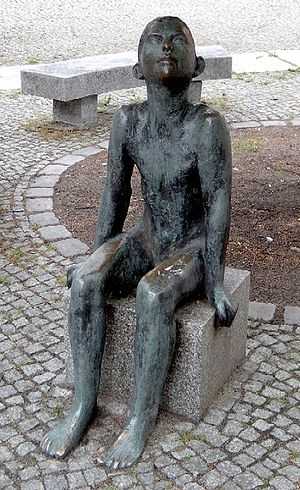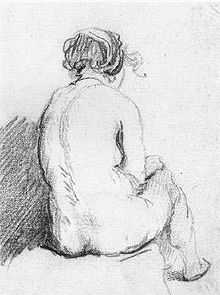Sitting

Sitting is a rest position supported in humans by the buttocks or thighs where the torso is more or less upright. Sitting for much of the day may pose significant health risks, and people who sit regularly for prolonged periods have higher mortality rates than those who do not.[1]
Role and evolution

Although chairs with backrests have only been common in Europe since the 16th century and office workers sitting at work was uncommon even in the early 20th century,[2] the British Chiropractic Association said in 2006 that 32% of the British population spent more than ten hours per day sitting down.[3]
Positions
On the floor
The most common ways of sitting on the floor involve bending the knees. One can also sit with the legs unbent, using something solid as support for the back or leaning on one's arms. Sitting with bent legs can be done with the legs mostly parallel or by crossing them over each other.
A common cross-legged position is with the lower part of both legs folded towards the body, crossing each other at the ankle or calf, with both ankles on the floor, sometimes with the feet tucked under the knees or thighs. The position is known in several European languages as tailor style, from the traditional working posture of tailors;[4] compare tailor's bunion. It is also named after various plains-dwelling nomads: in English Indian style, in many European languages "Turkish style", and in Japanese agura (胡座 The sitting style of non-Han ethnics (particularly Turks, Mongols and other Central Asians.)). In yoga it is known as sukhasana.
On a raised seat
Most raised surfaces at the appropriate height can be used as seats for humans, whether they are made for the purpose, such as chairs, stools and benches, or not. While the buttocks are nearly always rested on the raised surface, there are many differences in how one can hold one's legs and back.
There are two major styles of sitting on a raised surface. The first has one or two of the legs in front of the sitting person; in the second, sitting astride something, the legs incline outwards on either side of the body.
The feet can rest on the floor, or on a footrest, which can keep them vertical, horizontal, or at an angle in between. They can also dangle if the seat is sufficiently high. Legs can be kept right to the front of the body, spread apart, or one crossed over the other.
The upper body can be held upright, recline to either side or backwards, or one can lean forward.
Yoga, traditions, and spirituality

There are many seated positions in various traditions and rituals. Four examples are:
- Seiza (正座) "correct sitting" is a Japanese word which describes the traditional formal way of sitting in Japan. A related position is kiza (跪座), which differs in the tops of the feet being raised off the ground.
- Vajrasana (Diamond Pose) is a yoga posture (asana) similar to seiza.
- The lotus position involves resting each foot on the opposite thigh so that the soles face upwards.
- The Burmese position, named so because of its use in Buddhist sculptures in Burma, places both feet in front of the pelvis with knees bent and touching the floor to the sides. The heels are pointing toward pelvis or upward, and toes are pointed so that the tops of the feet lie on the ground. This looks similar to the cross legged position, but the feet are not placed underneath the thigh of the next leg, therefore the legs do not cross. Instead, one foot is placed in front of the other.
In various mythologies and folk magic, sitting is a magical act that connects the person who sits with other persons, states or places.[5]
Health risks

There is a significantly higher mortality rate among people who regularly sit for prolonged periods, and the risk is not negated by regular exercise, though it is lowered. The causes of mortality include heart disease, type 2 diabetes and cancer, specifically, breast, endometrial, colorectal, and epithelial ovarian cancer. Public health programs typically focus on increasing physical activity rather than reducing sitting time, and the most effective method for encouraging reduced sitting time is unknown as of 2015.[1] A 2015 Cochrane review found low-quality evidence for sit-stand desks and/or counseling as effective workplace programs to reduce the total time spent sitting and the number of instances of long-term sitting.[6]
Workplace programs to reduce sitting vary in method. They include sit-stand desks, counseling, workplace policy changes, walking/standing meetings, treadmill desks, breaks, and stepping devices.[6]
Kneeling chairs
The kneeling chair (often just referred to as "ergonomic chairs"), was designed to encourage better posture than the conventional chair. To sit in a kneeling chair one rests one's buttocks on the upper sloping pad and rests the front of the lower legs atop the lower pad, i.e., the human position as both sitting and kneeling at the same time.
See also
References
- ↑ 1.0 1.1 Biswas A, Oh PI, Faulkner GE, Bajaj RR, Silver MA, Mitchell MS et al. (2015). "Sedentary Time and Its Association With Risk for Disease Incidence, Mortality, and Hospitalization in Adults: A Systematic Review and Meta-analysis". Annals of Internal Medicine 162 (2): 123–32. doi:10.7326/M14-1651. PMID 25599350.
- ↑ "Sitting down can send you to an early grave: Why sofas (and your office chair) should carry a health warning...". dailymail.co.uk. March 3, 2013. Retrieved February 20, 2015.
Chairs with backs only became available to the affluent in Europe around the 13th century, and it was not until the 16th century that they became common. Until then, the chest, bench or stool were the everyday seats. Sitting at work is a recent fad, as well. In the 19th and early 20th centuries, office workers such as clerks, accountants and managers mostly stood. Sitting was equated with slacking.
- ↑ "Sitting straight 'bad for backs'". BBC. November 28, 2006. Retrieved February 20, 2015.
- ↑ "The Art of the Cut". History.org. Retrieved 2012-03-16.
- ↑ Čajkanović, Veselin; Živković, Marko (translator) (1996). "Magical Sitting". Anthropology of East Europe Review 14 (1). Retrieved 2007-07-09.
It is obvious from all the above that sitting, seen from the viewpoint of the history of religion, could be a magical act which, within the framework of analogic magic, will establish a certain relationship, a covenant.
- ↑ 6.0 6.1 Shrestha N, Ijaz S, Kukkonen-Harjula KT, Kumar S, Nwankwo CP (2015). "Workplace interventions for reducing sitting at work". The Cochrane Database of Systematic Reviews 1: CD010912. doi:10.1002/14651858.CD010912.pub2. PMID 25620219.
Further reading
- Chau JY, der Ploeg HP, van Uffelen JG, Wong J, Riphagen I, Healy GN et al. (2010). "Are workplace interventions to reduce sitting effective? A systematic review". Preventive Medicine 51 (5): 352–6. doi:10.1016/j.ypmed.2010.08.012. PMID 20801153.
- Chinapaw MJ, Proper KI, Brug J, van Mechelen W, Singh AS (2011). "Relationship between young peoples' sedentary behaviour and biomedical health indicators: a systematic review of prospective studies". Obesity Reviews : an Official Journal of the International Association for the Study of Obesity 12 (7): e621–32. doi:10.1111/j.1467-789X.2011.00865.x. PMID 21438990.
- Proper KI, Singh AS, van Mechelen W, Chinapaw MJ (2011). "Sedentary behaviors and health outcomes among adults: a systematic review of prospective studies". American Journal of Preventive Medicine 40 (2): 174–82. doi:10.1016/j.amepre.2010.10.015. PMID 21238866.
- Roffey DM, Wai EK, Bishop P, Kwon BK, Dagenais S (2010). "Causal assessment of occupational sitting and low back pain: results of a systematic review". The Spine Journal : Official Journal of the North American Spine Society 10 (3): 252–61. doi:10.1016/j.spinee.2009.12.005. PMID 20097618.
- Shrestha N, Ijaz S, Kukkonen-Harjula KT, Kumar S, Nwankwo CP (2015). "Workplace interventions for reducing sitting at work". The Cochrane Database of Systematic Reviews 1: CD010912. doi:10.1002/14651858.CD010912.pub2. PMID 25620219.
External links
| Wikimedia Commons has media related to Sitting. |
| Look up sitting in Wiktionary, the free dictionary. |